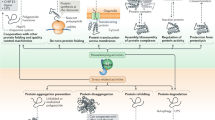Abstract
Kinetics of the chaperone activity of proteins Hsp70 and Hdj1 were analyzed in human U-937 promonocytes during their response to heat shock or to treatment with the echinochrome triacetyl glucoside derivative U-133. To measure the chaperone activity of both proteins, a special test was developed for their recognition and binding of a denatured protein. Using this test, the chaperone activity could be concurrently estimated in large numbers of cellular or tissue extracts. We also estimated the contents of both chaperones in cells by immunoblotting. The values for contents of Hsp70 and Hdj1 obtained by two independent test systems coincided, and this suggested that the substrate-binding activity could change proportionally to the chaperone content in the protein mixture. Therefore, the test developed by us can be employed for high throughput screening of drugs activating cellular chaperones. The analysis of quantity and activity of two cellular chaperones during the cell response to heat stress or to the drug-like substance U-133 showed that both factors caused the accumulation of chaperones with similar kinetics. We conclude that the efficiency of drug preconditioning could be close to the efficiency of hyperthermia and that the high activity of chaperones could be retained in human cells for no less than 1.5 days.
Similar content being viewed by others
Abbreviations
- CMLA:
-
carboxymethylated lactalbumin
- DTT:
-
dithiothreitol
- EIA:
-
enzyme immunoassay
- PBS:
-
phosphatebuffered saline
- U-103:
-
tetra-O-acetyl-β-D-glucopyranoside
- U-133:
-
echinochrome triacetyl glucoside
References
Naga, Y., Fujikake, N., Popiel, H. A., and Wada, K. (2010) Curr. Pharm. Biotechnol., 11, 188–197.
George, I., Geddis, M. S., Lill, Z., Lin, H., Gomez, T., Blank, M., Oz, M. C., and Goodman, R. (2008) J. Cell Physiol., 216, 816–823.
Beckham, J. T., Wilmink, G. J., Mackanos, M. A., Takahashi, K., Contag, C. H., Takahashi, T., and Jansen, E. D. (2008) Lasers Surg. Med., 40, 704–715.
Gong, B., Bell, B., Boor, P. J., Albrecht, T. B., Asimakis, G. K., and Motamedi, M. (2008) J. Surg. Res., 149, 177–183.
Brown, I. R. (2007) Ann. N. Y. Acad. Sci., 1113, 147–158.
Salminen, A., Lehtonen, M., Paimela, T., and Kaarniranta, K. (2010) Biochem. Biophys. Res. Commun., 394, 439–442.
Polonik, S. G., Tolkach, A. M., and Uvarova, N. I. (1994) Zh. Org. Khim., 30, 248–253.
Polonik, S. G. (2009) Khim. Prir. Soedin., 45, 212.
Eremenko, E. M., Antimonova, O. I., Shekalova, O. G., Polonik, S. G., Margulis, B. A., and Guzhova, I. V. (2010) Tsitologiya, 52, 235–241.
Komarova, E. Y., Afanasyeva, E. A., Bulatova, M. M., Cheetham, M. E., Margulis, B. A., and Guzhova, I. V. (2004) Cell Stress Chaperones, 9, 265–275.
Novoselov, S. S., Novoselova, T. V., Moskaliova, O. S., Margulis, B. A., and Guzhova, I. V. (2004) Tsitologiya, 46, 620–627.
Guzhova, I., and Margulis, B. (2006) Int. Rev. Cytol., 254, 101–149.
Bradford, M. M. (1976) Anal. Biochem., 72, 248–254.
Guzhova, I., Kislyakova, K., Moskaliova, O., Fridlanskaya, I., Tytell, M., Cheetham, M., and Margulis, B. (2001) Brain Res., 914, 66–73.
Freeman, B. C., Myers, M. P., Schumacher, R., and Morimoto, R. I. (1995) EMBO J., 14, 2281–2292.
Wawrzynow, A., and Zylicz, M. (1995) J. Biol. Chem., 270, 19300–19306.
Anckar, J., and Sistonen, L. (2007) Adv. Exp. Med. Biol., 594, 78–88.
Gidalevitz, T., Kikis, E. A., and Morimoto, R. I. (2010) Curr. Opin. Struct. Biol., 20, 23–32.
Freeman, B. C., and Morimoto, R. I. (1996) EMBO J., 15, 2969–2979.
Luders, J., Demand, J., Papp, O., and Hohfeld, J. (2000) J. Biol. Chem., 275, 14817–14823.
Author information
Authors and Affiliations
Corresponding author
Additional information
Original Russian Text © V. F. Lazarev, K. V. Onokhin, O. I. Antimonova, S. G. Polonik, I. V. Guzhova, B. A. Margulis, 2011, published in Biokhimiya, 2011, Vol. 76, No. 5, pp. 724–730.
Rights and permissions
About this article
Cite this article
Lazarev, V.F., Onokhin, K.V., Antimonova, O.I. et al. Kinetics of chaperone activity of proteins Hsp70 and Hdj1 in human leukemia U-937 cells after preconditioning with thermal shock or compound U-133. Biochemistry Moscow 76, 590–595 (2011). https://doi.org/10.1134/S0006297911050099
Received:
Revised:
Published:
Issue Date:
DOI: https://doi.org/10.1134/S0006297911050099




